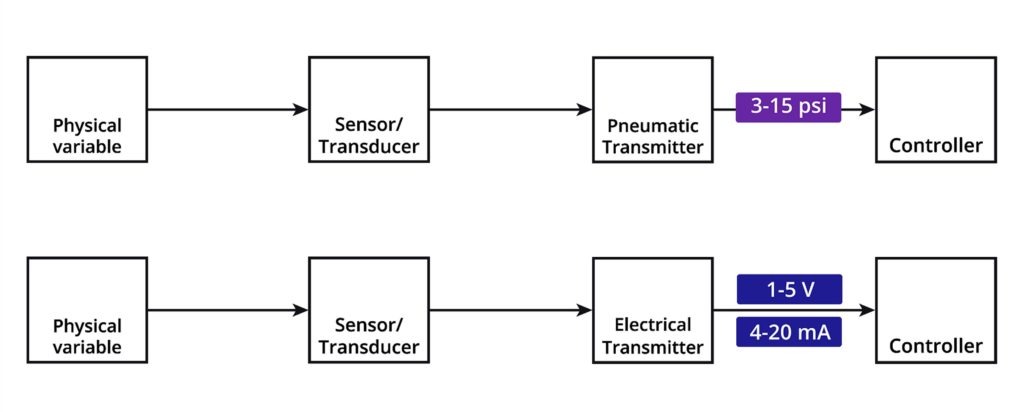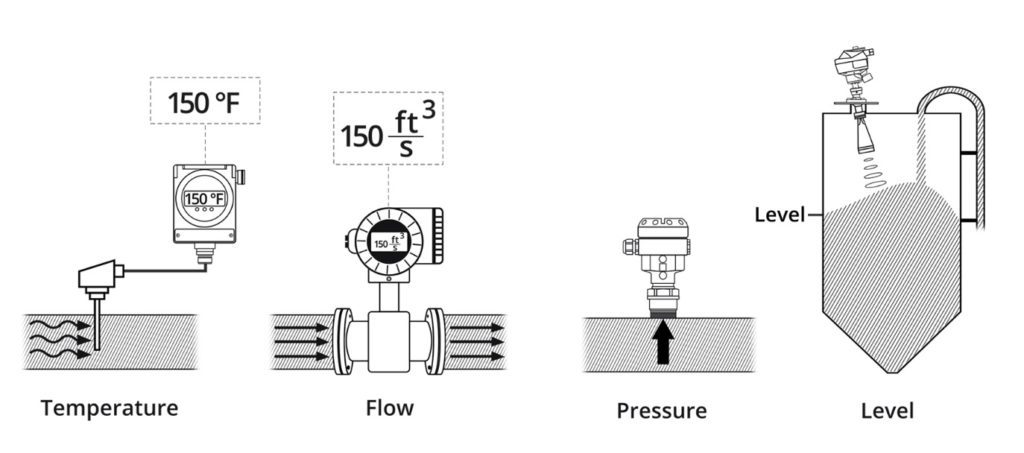What is a transmitter ?
For a process to be adequately controlled and manipulated, the variable of interest in the process (e.g. Temperature, Pressure or Flow) often called the Process Variable (PV) needs to be measured by a sensor which converts the measurement into a suitable signal format (4 – 20mA or digital) and then transmit it to a controller which makes the control decision and finally acts on a final control element in the control loop. What does this signal transmission is referred to as a transmitter.
Function of transmitter
The function of a Transmitter is to convert the signal produced by a sensor into a standardized instrumentation signal such as 3-15 PSI air pressure, 4-20 mA DC electric current, Fieldbus digital signal etc., which may then be conveyed to an indicating device, a controlling device, or both. The indicating or controlling device is often located in a centralized control room. The transmitter often combines a sensor and the transmitter in a single piece. The sensor measures the process variable and generate a proportional signal. The transmitter then amplifies and conditions the sensor signal for onward transmission to the receiving or controlling device.
Different types of transmitters
When the Transmitters Used in Process Instrumentation, the industrial transmitters can be broadly divided into two broad groups:
(a) Electronic Transmitters
(b) Pneumatic Transmitters
Electronic transmitters can either be analog or digital/ smart as the case may be. So, We can further group transmitters according to the types of signals they produce namely:
(a) Pneumatic Transmitters
(b) Analog Transmitters
(c) Digital Transmitters
Pneumatic transmitter vs electronic transmitter

Pneumatic Transmitters
Pneumatic transmitters output a pneumatic signal corresponding to the process variable. The pneumatic signal range that is commonly used in industrial plants today is the 3 – 15psig. 3psig corresponds to the lower range value (LRV) and 15psig corresponds to the upper range value (URV). It is still commonly used today especially in remote locations where electric power is not readily available.
A pneumatic pressure transmitter is supplied with air pressure typically 20 – 30 psig depending on the application. Process pressure is applied to the High port of the transmitter. As the process pressure varies, the transmitter produces an output signal (3 -15psig) that is proportional to the process pressure.
Electronic Transmitters
As the Electric transmitter can either be analog or digital/ smart as the case may be. So, Electronic transmitters can be grouped as digital transmitter and analog transmitter.
Digital Transmitters
Digital transmitters produce digital signals that are combined in a variety of ways to enhance communication with the devices; enhances diagnostic capabilities of the device and makes control of the devices and processes relatively easy and smooth. Digital signals are discrete levels or values that are combined in specific ways to represent process variables and also carry other important information, such as diagnostic information. Digital transmitters combine the digital signals in a variety of ways leading to various communication protocols such as Fieldbus, HART etc.
Most digital transmitters may be referred to as smart instruments. They have inbuilt microprocessors that helps in signal conditioning and processing and gives the devices some diagnostic capability.
Analog Transmitters
Analog transmitters are mostly electronic in nature. They output an electrical signal (current or voltage) whose magnitude represents a physical measurement or a control quantity. The transmitter is classified as being analog
by virtue of the fact that it uses an analog signal standard to communicate information. The most common standard for transmitting an analog signal is the 4-20 mA current signal. With this signal, a transmitter sends a small current, proportional to the physical measurement, through a set of wires. In this signal standard, 4mA represents the lowest possible measurement or the LRV (Lower Range Value) while the 20mA represents the highest possible measurement or URV (Upper Range Value).
Variables measured by the transmitter
When Transmitters Used in Process Instrumentation, there have four common process variables of interest in the process industries.
(a) Pressure
(b) Temperature
(c) Flow Level and
(d) Level

In addition to these variables, there is also the need to analyze various chemical compositions and components. Hence accordingly, the following transmitters are commonly used in the process industries:
(a) Pressure Transmitters
(b) Temperature Transmitters
(c) Flow Transmitters
(d) Level Transmitters
(e) Analytic Transmitters – 02(Oxygen), CO (Carbon Monoxide), PH etc.
Pressure Transmitters
Pressure transmitters, also called tryk transmitter, are essentially used in measuring various types of process pressures. We have:
(a) Absolute Pressure Transmitter – This transmitter measures the pressure relative to perfect vacuum pressure which know as vacuum transmitter.
(b) Gauge Pressure Transmitter-This transmitter measures the pressure relative to atmospheric pressure at a given location. When the pressure gauge reads 0 PSI, it is means pressure is atmospheric.
(c) Differential Pressure Transmitter – This transmitter measures the difference between two or more pressures introduced as inputs to the sensing unit. They are used to measure the pressure drop across an oil filter for example. They are also popularly used to measure flow or level in pressurized vessels.
Level Transmitters
Level transmitters are used to measure the level of a liquid or solid material within a vessel or space. These transmitters can measure level continuously or at determined points:
(a) Point Level Transmitters – Provide an output when a specific level measurement is reached. This output is generally in the form of an audible alarm or an electrical signal to turn on a switch.
(b) Continuous Level Transmitters – Measure level within a specified range and provide an output as a continuous reading in proportion to the changing level of the water transmitter.
There are various types of level transmitters in use in the process industries. Some of them include:
(a) Ultrasonic Level Transmitters – Used for non-contact level sensing of highly viscous liquids, as well as bulk solids.
(b) Conductive Level Transmitters – Used for point level detection of a wide range of conductive liquids such as water, and is especially well suited for highly corrosive liquids such as caustic soda, hydrochloric acid, and similar liquids.
(c) Pneumatic Level Transmitters – Used in hazardous environments and where there is no electric power. They are also ideal in applications involving heavy sludge or slurry.
(d) Capacitance Level Transmitters – They are used in liquids that are non-conductive and have a high dielectric constant and can be used for continuous level monitoring.
(e) Hydrostatic based Level Transmitters – These transmitters use the hydrostatic pressure at a point in a liquid to determine level.
Temperature Transmitters
A temperature transmitter comprises a temperature sensor and transmitter. The transmitter receives a signal from temperature sensors such as a thermocouple or RTD, computes the temperature based on this signal and then converts it to a 4 – 20mA output signal meant for a receiving device such as a controller.
There are different types of temperature transmitters used in the process industries utilizing various temperature measurement technologies. The most common types include:
(a) Thermocouple type Temperature Transmitter – With a thermocouple, the electromotive force generated by changes in the process temperature is used to calculate temperature.
(b) RTD type Temperature Transmitter – When an RTD is used, changes in process temperature results in change in the electrical resistance of the RTD sensor. This relationship between process temperature and electrical resistance is then used to calculate temperature by the transmitter.
Flow Transmitters
A flow transmitter is used to measure and indicate flow. It combines a flow sensor and transmitter in one piece.The flow signal from the flow sensor is used by the transmitter to generate a 4 – 20m A output that represents changes in flow in the actual process.
Various technologies are used in flow transmitters to measure flow. They range from velocity based flow sensors, Ultrasonic flow sensors to Differential pressure flow sensors. Please see flow meters for more on some of the technologies used.
Conclusion
The function of the transmitter is to measure the process variable and generate a proportional signal. Smart Transmitters not only produce the 4 to 20 mA process variable signal, but also transmit and receive digital information such as Calibration Data, and Sensor Diagnostics.




